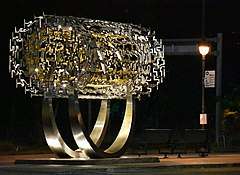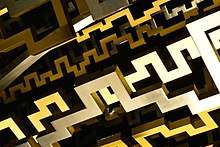Freedom Sculpture
The Freedom Sculpture or Freedom: A Shared Dream,[1] is a 20,400 lb (9,300 kg) stainless steel, gold, and silver public art sculpture in Century City, California, by artist and architect Cecil Balmond. It was commissioned by the Farhang Foundation and was inspired by the 2,500 year old Cyrus Cylinder, considered an early written declaration of human rights. It commemorates the declaration of Cyrus the Great, King of ancient Iran, which was viewed as granting individual and religious freedoms to all those within his vast and culturally diverse empire.[2][3]
| The Freedom Sculpture | |
|---|---|
| Persian: تندیس آزادی | |
 | |
| Artist | Cecil Balmond |
| Year | July 4th, 2017 |
| Medium | Stainless Steel |
| Subject | Human rights, Freedom of religion, Multiculturalism, Inclusiveness |
| Dimensions | 4.6m x 6.1m x 2.75m |
| Weight | 9,253 kg |
| Location | Century City, Los Angeles, California. |
| Website | www |


Design and construction
Balmond's design was selected among over 300 worldwide entries. The 20,400-pound (9,253 kg) sculptural interpretation of the Cyrus Cylinder is made of two stainless steel water jet cut stainless steel double cylinders (gold interior cylinder, silver exterior cylinder), supported by two 15-foot diameter stainless steel half-rings. The sculpture sits on a travertine stone platform and includes lighting. Its overall dimensions are 15 feet (4.6m) high by 20 feet (6.1m) wide by 9 feet (2.75m) deep.[1]
Donation and unveiling
The sculpture was officially donated to the city of Los Angeles and unveiled on 4 July 2017 to a crowd of over 75,000 attendees.[4][5][6] At the unveiling ceremony, a proclamation of support by California Governor Jerry Brown was read.[7] Also, Los Angeles Mayor Eric Garcetti sent a video message [8] and Fifth District Councilman Paul Koretz presented a certificate of appreciation to the Farhang Foundation and the Iranian-American community.[9]
The sculpture is located on Santa Monica Boulevard on a street median at Century City, Los Angeles, California.
Funding and support
The Freedom Sculpture generated significant support on social media, with over 1.1 million fans supporting its creation with over $2.2 million.[3] While crowd-funding played a significant role in raising money for the Freedom Sculpture, a relatively small group of people, comprising the Freedom Sculpture Founders Circle, contributed over 50% of the funds raised. [10]
Scholarly views of the inscription
The interpretation of the Cylinder as a "charter of human rights" has been described by some historians as "rather anachronistic" and tendentious.[11][12][13][14] It has been dismissed as a "misunderstanding"[15] and characterized as political propaganda devised by the Pahlavi regime.[16] The German historian Josef Wiesehöfer comments that the portrayal of Cyrus as a champion of human rights is as illusory as the image of the "humane and enlightened Shah of Persia".[17] D. Fairchild Ruggles and Helaine Silverman describe the Shah's aim as an effort to legitimize the Iranian nation and his own regime, and to counter the growing influence of Islamic fundamentalism, by creating an alternative narrative rooted in the ancient Persian past.[18]
Writing in the immediate aftermath of the Shah's anniversary commemorations, the British Museum's C.B.F. Walker comments that the "essential character of the Cyrus Cylinder [is not] a general declaration of human rights or religious toleration but simply a building inscription, in the Babylonian and Assyrian tradition, commemorating Cyrus's restoration of the city of Babylon and the worship of Marduk previously neglected by Nabonidus".[19] Two professors specializing in the history of the ancient Near East, Bill T. Arnold and Piotr Michalowski, comment: "Generically, it belongs with other foundation deposit inscriptions; it is not an edict of any kind, nor does it provide any unusual human rights declaration as is sometimes claimed."[20] Lloyd Llewellyn-Jones of the University of Edinburgh notes that "there is nothing in the text" that suggests the concept of human rights.[13] Neil MacGregor comments:
Comparison by scholars in the British Museum with other similar texts, however, showed that rulers in ancient Iraq had been making comparable declarations upon succeeding to the [Babylonian] throne for two millennia before Cyrus […] it is one of the museum's tasks to resist the narrowing of the object's meaning and its appropriation to one political agenda.[21]
He cautions that while the Cylinder is "clearly linked with the history of Iran," it is "in no real sense an Iranian document: it is part of a much larger history of the ancient Near East, of Mesopotamian kingship, and of the Jewish diaspora".[21]
Some historians,[22] as well as writers on human rights, have supported the interpretation of the Cyrus Cylinder as a human rights charter.[23][24] W.J. Talbott, an American philosopher, believes the concept of human rights is a 20th-century concept but describes Cyrus as "perhaps the earliest known advocate of religious tolerance" and suggests that "ideas that led to the development of human rights are not limited to one cultural tradition."[25] The Iranian lawyer Hirad Abtahi argues that viewing the Cylinder as merely "an instrument of legitimizing royal rule" is unjustified, as Cyrus issued the document and granted those rights when he was at the height of his power, with neither popular opposition nor visible external threat to force his hand.[26] A former Iranian prime minister, Hassan Pirnia, writing in the early 20th century, characterizes the Cylinder as "discuss[ing] human rights in a way unique for the era, dealing with ways to protect the honor, prestige, and religious beliefs of all the nations dependent to Iran in those days".[27]
Notable supporters
The Freedom Sculpture Founders Circle:[10]
- Nushin and Farhad Mohit (Flipagram, Shopzilla, BizRate.com)
- Anousheh and Ali Razi (Stratham Group)
- Anna and Aria Mehrabi (Pacific Star Capital)
- Shirin and Michael Amin (Primex World Inc.)
- Dionne and Francis Najafi (Pivotal Group)
- Tina and Hamid Moghadam (Prologis)
- Soraya and Younes Nazarian (Philanthropists)
- Bita Daryabari (Philanthropist)
- Katy and Michael Saei (First Financial Capital)
- Salar Kamangar (YouTube & Google)
- Faraj Alalaei and Susan Akabarpour (Acquantia, Mavatar)
- Andy Saberi (Entrepreneur)
- Mahshid and Ebi Hamedi (Persian pop singer)
Other notable supporters
- Jerry Brown (Governor of California)
- Eric Garcetti (Mayor of Los Angeles)
- Paul Koretz (Fifth District Councilman)
- Anthony Rendon (Speaker of the California State Assembly)
- Elon Musk (Tesla and Space X)
- Lynda Resnick (Pom and Fiji Water)
- Michael Moritz (Sequoia Capital)
- Firouz Naderi (a former NASA manager)
- Mark Amin (Film Producer)
- Stewart and Lynda Resnick (Wonderful)
- Goli Ameri (Former U.S ambassador to Sweden)
- Ahmad Tea (Fairfax, Virginia)
- Iranian American Women Foundation
See also
References
- ""The Freedom Sculpture" or "Freedom: A Shared Dream"". Public Art in Public Places. May 13, 2020. Retrieved May 14, 2020.
- "Century City Freedom Sculpture unveiled on Santa Monica Boulevard median". La.curbed.com. Retrieved January 24, 2018.
- Hamilton, Matt (July 4, 2017). "'Los Angeles embodies diversity.' The city's new sculpture celebrating freedom is unveiled". Los Angeles Times. Retrieved January 24, 2018.
- "Freedom Sculpture unveiled in LA". Abc7.com. July 4, 2017. Retrieved January 24, 2018.
- "LA Freedom Sculpture To Be Unveiled Tuesday". Losangeles.cbslocal.com. July 4, 2017. Retrieved January 24, 2018.
- "LA Freedom Sculpture to Be Unveiled at Fourth of July Party". Associated Press. Archived from the original on July 5, 2017. Retrieved July 10, 2017 – via US News.
- "Freedom Sculpture" (PDF). Freedomsculpture.org. Retrieved January 24, 2018.
- Mehrfar, K. E. "O.C. Iranian Americans attend dedication of Freedom Sculpture". Los Angeles Times. Retrieved January 24, 2018.
- "Certificate of Appreciation" (PDF). Freedomsculpture.org. Retrieved January 24, 2018.
- "Freedom Sculpture Founders' Circle". Wall.freedomsculpture.org. Retrieved January 24, 2018.
- Daniel, p. 39
- Briant, p. 47
- Llewellyn-Jones, p. 104
- Curtis, Tallis & Andre-Salvini, p. 59
- Mitchell, p. 83
- Kuhrt (1983), pp. 83–97
- Wiesehöfer (1999), pp. 55–68
- Silverman, Helaine; Ruggles, D. Fairchild (2008). Cultural Heritage and Human Rights. Springer. p. 11. ISBN 978-0-387-76579-2.
- Walker, pp. 158–159
- Arnold, pp. 426–430
- MacGregor
- Craig A. Lockard, Societies, Networks, and Transitions: A Global History: To 1500 (2007) p. 147; Yunus Jaffery, editor, History of Persian literature (1981), p. 121 (author unknown);
- Damien Kingsbury, Human Rights in Asia: A Reassessment of the Asian Values Debate (Macmillan, 2008) page 21; Sabine C. Carey, The Politics of Human Rights: The Quest for Dignity (2010) p 19; Paul Gordon Lauren, The Evolution of International Human Rights (2003) Page 11; Willem Adriaan Veenhoven, Case Studies on Human Rights and Fundamental Freedoms: A World Survey: Volume 1 (1975) Page 244
- Decolonisation, Globalisation: Language-in-Education Policy and Practice, Peter W. Martin, p. 99
- Talbott, W.J. Which Rights Should be Universal?, p. 40. Oxford University Press US, 2005. ISBN 978-0-19-517347-5
- Abtahi, pp. 1–38.
- Cited in Shabani, p. 21